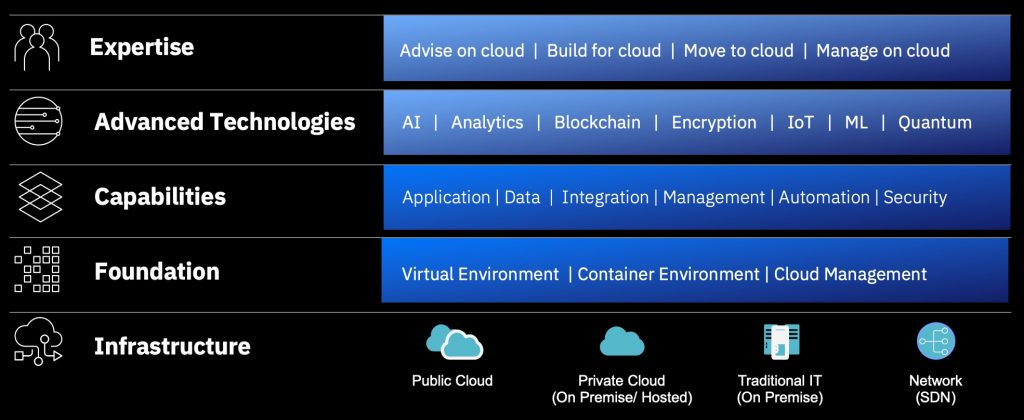Services
Planning Your Hybrid Multicloud Success with Open Source
December 23, 2019 | Written by: Matthew Glitzer
Categorized: Hybrid Cloud | Open Source | Services
Share this post:

Open source is now an enterprise reality. According to Forrester1, 90% of enterprises are already using two or more types of open source technologies; more than half are using five or more.
IBM’s recent US$34 billion acquisition of Red Hat has helped accelerate the enterprise adoption of open source. CIOs can now more readily access open-source innovation through Red Hat open architecture capabilities in order to drive critical initiatives like hybrid multicloud, Platform as a Service (PaaS) and infrastructure automation. As with anything, proper planning and strategy is required to foster success.
The Value of Open
There are many reasons for using open source for hybrid multicloud – cost and technical efficiency, more agile and cutting-edge development, open standards and great talent pools.
Open source’s promise of “modernize once, innovate anywhere” is very attractive. But, companies need to consider the following issues when developing their future enterprise architecture and open source’s role in it:
- Delivering application modernization and migration at speed
- Supporting cloud-native innovation with agility
- Driving business resiliency in a hybrid multicloud environment
- Orchestrating and simplifying ongoing management and support
Essentially, CIOs must think through the role of open source technology in their business and take a measure approach to its implementation.
IBM offers one such approach. It features four common layers: Foundation, Capabilities, Advanced Services, and Expertise all layered on top of the Infrastructure layer as seen below.

The goal of this approach is to help clients develop a framework to understand how open-source technology and open architecture (both current or future ones) fit into their overall approach and specifically how open source can and will drive their hybrid multicloud strategy. A key aspect of the approach is that it is a lifecycle approach that is tailored to each client’s current maturity and capabilities and aims to leverage existing investment and skills into the future roadmap.
Foundational Step
IBM believes that each of the four layers defined above are of equal importance, but that developing and implementing the Foundation layer first, is crucial for long term success. For example, Company A has decided to implement a microservices and container platform for application development and deployment. It may make a technical choice to use a Kubernetes platform in one cloud environment and another technology for their on-premise environments, thereby creating the need to maintain multiple technical capabilities and creating unnecessary complexity and adding unnecessary cost. In a hybrid multicloud world, open source is intended to reduce complexity, improve automation and accelerate digital transformation. Proper planning at the Foundation layer is required to simplify these technical platforms and position a client for scale in a hybrid multicloud world.
The Future is Open
Open source technologies and open architectures will play an increasingly central role in the implementation of hybrid multicloud architectures. The right approach up front will materially impact the cost and eventual success of these efforts. There is no better time to take a step back, think about what tomorrow may bring and to plan for this future together.
Look out for our subsequent blogs, where we will take a deep dive into scenarios and use cases where enterprises unlocked the hybrid multicloud advantage with open source and open architectures.
Next Steps
Take a step back, and understand the breadth of cloud services IBM already offers at: https://www.ibm.com/hk-en/services/cloud
- A commissioned study conducted by Forrester Consulting on behalf of IBM, September 2019

General Manager, Global Technology Services, IBM Hong Kong
Why the Future of Financial Services Lie in Extreme Digitization
Three years into a global COVID-19 pandemic and financial services firms are beginning to face a different market landscape. The biggest change is customer expectations. After shifting to a more digital lifestyle, retail and business customers want the same level of seamless experience that fintechs, virtual banks, platform players, and SaaS applications offer. It’s […]
大學採用IBM雲端平台 學生分析數據從此變得更簡單
身處於數碼科技年代,數據分析在教育學習領域中亦擔當了重要的角色,要令每位學生、教職員均懂得如何應用它成為重要一課。為了令學生能裝備自己於數碼時代保持敏銳觸角,香港樹仁大學(仁大)啟用了三個實驗室,當中包括大數據實驗室。但對非科技科學生和學系來說,分析大數據的技術及工具很複雜和難用。因此,仁大選擇了IBM Cloud Pak® for Data平台,解決這個難題,令數據分析變得更簡單。
機密運算杜絕非法存取數據 助建立可信企業雲端營運環境
(文章於2021年7月2日在香港經濟日報網站刊登) 數據安全,是金融和電訊等需要處理敏感資料的行業,採用公共雲及混合雲服務的一個主要障礙。一般雲端服務商可以為處於靜止儲存狀態的企業數據,進行高強度加密,盡量減低被破解的機率;但是在運算和處理前的一瞬間,這些數據還是必須被解密。隨著科技日新月異,這種以往看來安全的狀態越來越可能被不法分子有機可乘。


